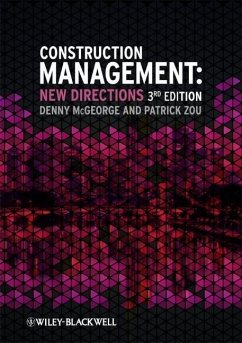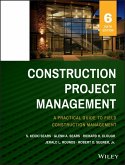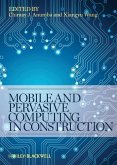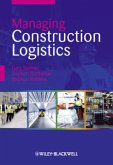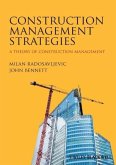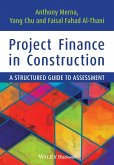- Broschiertes Buch
- Merkliste
- Auf die Merkliste
- Bewerten Bewerten
- Teilen
- Produkt teilen
- Produkterinnerung
- Produkterinnerung
The construction industry faces continual challenges and demands, due to market conditions and coercion by governments, for improvements in safety, quality and cost control, and in the avoidance of contractual disputes. To meet these challenges construction enterprises need to constantly seek new directions and business models in construction management. A number of tools, methods and concepts have been developed and advocated as aids to achieving improved performance, but many in the industry find them confusing or are sceptical of their relevance.
The third edition of Construction…mehr
Andere Kunden interessierten sich auch für
![Construction Project Management Construction Project Management]() S. Keoki SearsConstruction Project Management98,99 €
S. Keoki SearsConstruction Project Management98,99 €![Mobile and Pervasive Computing in Construction Mobile and Pervasive Computing in Construction]() Mobile and Pervasive Computing in Construction149,99 €
Mobile and Pervasive Computing in Construction149,99 €![Managing Construction Logistics Managing Construction Logistics]() Gary SullivanManaging Construction Logistics82,99 €
Gary SullivanManaging Construction Logistics82,99 €![Value Management of Construction Projects Value Management of Construction Projects]() John KellyValue Management of Construction Projects88,99 €
John KellyValue Management of Construction Projects88,99 €![Construction Management Strategies Construction Management Strategies]() Milan RadosavljevicConstruction Management Strategies63,99 €
Milan RadosavljevicConstruction Management Strategies63,99 €![Project Finance in Construction Project Finance in Construction]() Tony MernaProject Finance in Construction89,99 €
Tony MernaProject Finance in Construction89,99 €![Global Engineering and Construction Global Engineering and Construction]() J. K. YatesGlobal Engineering and Construction135,99 €
J. K. YatesGlobal Engineering and Construction135,99 €-
-
-
The construction industry faces continual challenges and demands, due to market conditions and coercion by governments, for improvements in safety, quality and cost control, and in the avoidance of contractual disputes. To meet these challenges construction enterprises need to constantly seek new directions and business models in construction management. A number of tools, methods and concepts have been developed and advocated as aids to achieving improved performance, but many in the industry find them confusing or are sceptical of their relevance.
The third edition of Construction Management: New Directionsbrings together, in a single volume, detailed discussion of a range of contemporary management concepts which are relevant to the construction industry, including strategic management; benchmarking; reengineering; partnering and alliancing; enterprise risk management; total safety management; total quality management; value management and constructability. It provides a straightforward, accessible and objective account of these concepts, showing how they interrelate and can be used to improve the performance of the construction firm.
This research based text will be essential reading for industry leaders and practitioners, as well as researchers, postgraduate and senior undergraduate students.
From a review of previous editions
I am in no doubt that this book will quickly become a favourite among students and practitioners alike --Construction Manager
Hinweis: Dieser Artikel kann nur an eine deutsche Lieferadresse ausgeliefert werden.
The third edition of Construction Management: New Directionsbrings together, in a single volume, detailed discussion of a range of contemporary management concepts which are relevant to the construction industry, including strategic management; benchmarking; reengineering; partnering and alliancing; enterprise risk management; total safety management; total quality management; value management and constructability. It provides a straightforward, accessible and objective account of these concepts, showing how they interrelate and can be used to improve the performance of the construction firm.
This research based text will be essential reading for industry leaders and practitioners, as well as researchers, postgraduate and senior undergraduate students.
From a review of previous editions
I am in no doubt that this book will quickly become a favourite among students and practitioners alike --Construction Manager
Hinweis: Dieser Artikel kann nur an eine deutsche Lieferadresse ausgeliefert werden.
Produktdetails
- Produktdetails
- Verlag: Wiley & Sons
- 3. Aufl.
- Seitenzahl: 320
- Erscheinungstermin: 17. Dezember 2012
- Englisch
- Abmessung: 239mm x 173mm x 18mm
- Gewicht: 522g
- ISBN-13: 9780470674017
- ISBN-10: 0470674016
- Artikelnr.: 36519497
- Herstellerkennzeichnung
- Libri GmbH
- Europaallee 1
- 36244 Bad Hersfeld
- gpsr@libri.de
- Verlag: Wiley & Sons
- 3. Aufl.
- Seitenzahl: 320
- Erscheinungstermin: 17. Dezember 2012
- Englisch
- Abmessung: 239mm x 173mm x 18mm
- Gewicht: 522g
- ISBN-13: 9780470674017
- ISBN-10: 0470674016
- Artikelnr.: 36519497
- Herstellerkennzeichnung
- Libri GmbH
- Europaallee 1
- 36244 Bad Hersfeld
- gpsr@libri.de
Denny McGeorge is Emeritus Professor in the School of Architecture and Built Environment at the University of Newcastle, Australia; an Honorary Professor at the University of New South Wales and a Visiting Professor at the University of Salford. Patrick Zou is Professor and Head of Discipline, Building and Construction Management at the University of Canberra, Australia. Prior to joining the University of Canberra, he was associate professor and director of the construction management and property program at the University of New South Wales, Australia. He is Guest Professor at Hunan University and Shenzhen University, and was Visiting Scholar at the National University of Singapore, University of Florida, Tsinghua University and Renmin University of China.
Preface to Third Edition ix
Acknowledgements xiii
1 The Culture of the Construction Industry 1
The book's contents 4
References 7
2 Strategic Management 9
Introduction 9
Overview 10
Strategic management process 12
Strategic management in construction 14
Paradoxes of strategic management processes in construction 17
Developing and implementing strategy in construction 18
Change management 19
Linking operational actions to strategy using a balanced scorecard 20
Stakeholder identification, analysis and consultation 22
Strategic management in action - a case study of Arup 25
An integrated strategic management framework 30
Conclusion 32
References 32
3 Benchmarking 35
Introduction 35
Definition of benchmarking 37
Historical development 38
Types of benchmarking 39
The process of benchmarking 42
The benchmarking team 54
Benchmarking Code of Conduct 55
Legal considerations 55
Benchmarking: The major issues 56
Case studies 59
Conclusion 61
References 62
4 Reengineering 65
Introduction 65
Reengineering: What's in a name? 67
Origins of reengineering 68
Reengineering in a construction industry context 68
The goals of reengineering 70
Reengineering methodology 73
Pitfalls of reengineering 78
Information technology and reengineering 80
Reengineering from a European perspective 83
A case study of a process reengineering study in the Australian
construction industry 84
Conclusion 92
References 94
5 Partnering and Alliancing 97
Introduction 97
The origins of partnering 98
Partnering in a construction industry context 98
The goals of partnering 99
Categories of partnering 100
Project partnering 101
Strategic or multi-project partnering 112
Legal and contractual implications of partnering 114
Dispute resolution 117
Partnering: Overview 118
Project alliancing - a natural progression from project partnering? 120
Alliance definitions 121
Alliancing in the construction industry 122
The differences between alliancing and partnering 122
Critical success factors in alliancing 124
The financial arrangements 125
The project outcome 126
Postscript 127
References 128
6 Enterprise Risk Management 132
Introduction 132
Why ERM in the construction industry? 133
Key terms and definitions 135
ERM principles and processes 136
The COSO ERM 137
AS/NZS ISO 31000 Risk Management Standard 138
Establish objectives, context and criteria 138
Risk identification 140
Risk analysis and evaluation 140
Risk response and monitoring 141
Risk review and learning 142
Risk communication and consultation 143
A comparison of risk management processes 143
ERM application techniques 144
Implementing ERM in the construction industry 144
Organisational culture and ERM 146
ERM performance 147
ERM misconceptions 148
Relationship between ERM and strategic planning 148
Improving ERM capability and maturity 149
The ERM3 model 150
ERM3 example 154
ERM capability improvement 156
Project risk management 157
Conclusion 159
References 160
7 Total Safety Management 163
Introduction 163
The science of safety management 164
What is safety risk assessment at the design stage? 164
Why safety risk assessment at design? 165
Barriers for implementing safety risk assessment at design 167
Methods for safety risk assessment at design 167
Case study 169
The art of safety management 176
Components of a safety culture 177
Dimensions of a safety culture 178
Safety culture maturity models 179
A construction safety maturity model 181
Development of measurement instruments 182
Conclusion 184
References 186
8 Total Quality Management 191
Introduction 191
Definition of TQM 191
What is quality? 193
Historical development of TQM 194
The need for a paradigm shift 197
A change in the culture of the construction industry 198
Customer focus 200
Integration 201
The all-embracing nature of TQM 206
Continuous improvement 206
Quality costs and the cost of quality 207
Universal standards of quality such as ISO 9000 208
Change management 209
The methods of TQM 209
How to implement TQM 209
Kaizen 210
Current research into TQM in the construction industry 210
Conclusion 211
References 212
9 Value Management 214
Introduction 214
Historical development 215
Function analysis 218
Organisation of the function analysis study 226
Who should carry out the study? 226
Who should constitute the team? 227
How should alternatives be evaluated? 231
Value management as a system 232
The American system 233
A case study of value management in the United States 233
The British/European system 235
A case study of value management in the UK 236
Value management in Australia 239
A case study of value management (and constructability) in Australia 240
The Japanese system 244
A case study of value management in Japan 244
Why are the systems different? 245
Differences in the style of management 246
Differences in management systems 246
The relationship between value management and quantity surveying 247
Conclusion 247
References 249
10 Constructability 251
Introduction 251
Origins 252
The goals of constructability 253
Implementing constructability 255
Constructability in practice 258
Constructability and the building product 260
Constructability and Building Information Modelling 263
Good and bad constructability 264
Quantifying the benefits of constructability 269
Conclusion 270
References 271
11 Linking the Concepts 274
References 280
Bibliography 282
Index 296
Acknowledgements xiii
1 The Culture of the Construction Industry 1
The book's contents 4
References 7
2 Strategic Management 9
Introduction 9
Overview 10
Strategic management process 12
Strategic management in construction 14
Paradoxes of strategic management processes in construction 17
Developing and implementing strategy in construction 18
Change management 19
Linking operational actions to strategy using a balanced scorecard 20
Stakeholder identification, analysis and consultation 22
Strategic management in action - a case study of Arup 25
An integrated strategic management framework 30
Conclusion 32
References 32
3 Benchmarking 35
Introduction 35
Definition of benchmarking 37
Historical development 38
Types of benchmarking 39
The process of benchmarking 42
The benchmarking team 54
Benchmarking Code of Conduct 55
Legal considerations 55
Benchmarking: The major issues 56
Case studies 59
Conclusion 61
References 62
4 Reengineering 65
Introduction 65
Reengineering: What's in a name? 67
Origins of reengineering 68
Reengineering in a construction industry context 68
The goals of reengineering 70
Reengineering methodology 73
Pitfalls of reengineering 78
Information technology and reengineering 80
Reengineering from a European perspective 83
A case study of a process reengineering study in the Australian
construction industry 84
Conclusion 92
References 94
5 Partnering and Alliancing 97
Introduction 97
The origins of partnering 98
Partnering in a construction industry context 98
The goals of partnering 99
Categories of partnering 100
Project partnering 101
Strategic or multi-project partnering 112
Legal and contractual implications of partnering 114
Dispute resolution 117
Partnering: Overview 118
Project alliancing - a natural progression from project partnering? 120
Alliance definitions 121
Alliancing in the construction industry 122
The differences between alliancing and partnering 122
Critical success factors in alliancing 124
The financial arrangements 125
The project outcome 126
Postscript 127
References 128
6 Enterprise Risk Management 132
Introduction 132
Why ERM in the construction industry? 133
Key terms and definitions 135
ERM principles and processes 136
The COSO ERM 137
AS/NZS ISO 31000 Risk Management Standard 138
Establish objectives, context and criteria 138
Risk identification 140
Risk analysis and evaluation 140
Risk response and monitoring 141
Risk review and learning 142
Risk communication and consultation 143
A comparison of risk management processes 143
ERM application techniques 144
Implementing ERM in the construction industry 144
Organisational culture and ERM 146
ERM performance 147
ERM misconceptions 148
Relationship between ERM and strategic planning 148
Improving ERM capability and maturity 149
The ERM3 model 150
ERM3 example 154
ERM capability improvement 156
Project risk management 157
Conclusion 159
References 160
7 Total Safety Management 163
Introduction 163
The science of safety management 164
What is safety risk assessment at the design stage? 164
Why safety risk assessment at design? 165
Barriers for implementing safety risk assessment at design 167
Methods for safety risk assessment at design 167
Case study 169
The art of safety management 176
Components of a safety culture 177
Dimensions of a safety culture 178
Safety culture maturity models 179
A construction safety maturity model 181
Development of measurement instruments 182
Conclusion 184
References 186
8 Total Quality Management 191
Introduction 191
Definition of TQM 191
What is quality? 193
Historical development of TQM 194
The need for a paradigm shift 197
A change in the culture of the construction industry 198
Customer focus 200
Integration 201
The all-embracing nature of TQM 206
Continuous improvement 206
Quality costs and the cost of quality 207
Universal standards of quality such as ISO 9000 208
Change management 209
The methods of TQM 209
How to implement TQM 209
Kaizen 210
Current research into TQM in the construction industry 210
Conclusion 211
References 212
9 Value Management 214
Introduction 214
Historical development 215
Function analysis 218
Organisation of the function analysis study 226
Who should carry out the study? 226
Who should constitute the team? 227
How should alternatives be evaluated? 231
Value management as a system 232
The American system 233
A case study of value management in the United States 233
The British/European system 235
A case study of value management in the UK 236
Value management in Australia 239
A case study of value management (and constructability) in Australia 240
The Japanese system 244
A case study of value management in Japan 244
Why are the systems different? 245
Differences in the style of management 246
Differences in management systems 246
The relationship between value management and quantity surveying 247
Conclusion 247
References 249
10 Constructability 251
Introduction 251
Origins 252
The goals of constructability 253
Implementing constructability 255
Constructability in practice 258
Constructability and the building product 260
Constructability and Building Information Modelling 263
Good and bad constructability 264
Quantifying the benefits of constructability 269
Conclusion 270
References 271
11 Linking the Concepts 274
References 280
Bibliography 282
Index 296
Preface to Third Edition ix
Acknowledgements xiii
1 The Culture of the Construction Industry 1
The book's contents 4
References 7
2 Strategic Management 9
Introduction 9
Overview 10
Strategic management process 12
Strategic management in construction 14
Paradoxes of strategic management processes in construction 17
Developing and implementing strategy in construction 18
Change management 19
Linking operational actions to strategy using a balanced scorecard 20
Stakeholder identification, analysis and consultation 22
Strategic management in action - a case study of Arup 25
An integrated strategic management framework 30
Conclusion 32
References 32
3 Benchmarking 35
Introduction 35
Definition of benchmarking 37
Historical development 38
Types of benchmarking 39
The process of benchmarking 42
The benchmarking team 54
Benchmarking Code of Conduct 55
Legal considerations 55
Benchmarking: The major issues 56
Case studies 59
Conclusion 61
References 62
4 Reengineering 65
Introduction 65
Reengineering: What's in a name? 67
Origins of reengineering 68
Reengineering in a construction industry context 68
The goals of reengineering 70
Reengineering methodology 73
Pitfalls of reengineering 78
Information technology and reengineering 80
Reengineering from a European perspective 83
A case study of a process reengineering study in the Australian
construction industry 84
Conclusion 92
References 94
5 Partnering and Alliancing 97
Introduction 97
The origins of partnering 98
Partnering in a construction industry context 98
The goals of partnering 99
Categories of partnering 100
Project partnering 101
Strategic or multi-project partnering 112
Legal and contractual implications of partnering 114
Dispute resolution 117
Partnering: Overview 118
Project alliancing - a natural progression from project partnering? 120
Alliance definitions 121
Alliancing in the construction industry 122
The differences between alliancing and partnering 122
Critical success factors in alliancing 124
The financial arrangements 125
The project outcome 126
Postscript 127
References 128
6 Enterprise Risk Management 132
Introduction 132
Why ERM in the construction industry? 133
Key terms and definitions 135
ERM principles and processes 136
The COSO ERM 137
AS/NZS ISO 31000 Risk Management Standard 138
Establish objectives, context and criteria 138
Risk identification 140
Risk analysis and evaluation 140
Risk response and monitoring 141
Risk review and learning 142
Risk communication and consultation 143
A comparison of risk management processes 143
ERM application techniques 144
Implementing ERM in the construction industry 144
Organisational culture and ERM 146
ERM performance 147
ERM misconceptions 148
Relationship between ERM and strategic planning 148
Improving ERM capability and maturity 149
The ERM3 model 150
ERM3 example 154
ERM capability improvement 156
Project risk management 157
Conclusion 159
References 160
7 Total Safety Management 163
Introduction 163
The science of safety management 164
What is safety risk assessment at the design stage? 164
Why safety risk assessment at design? 165
Barriers for implementing safety risk assessment at design 167
Methods for safety risk assessment at design 167
Case study 169
The art of safety management 176
Components of a safety culture 177
Dimensions of a safety culture 178
Safety culture maturity models 179
A construction safety maturity model 181
Development of measurement instruments 182
Conclusion 184
References 186
8 Total Quality Management 191
Introduction 191
Definition of TQM 191
What is quality? 193
Historical development of TQM 194
The need for a paradigm shift 197
A change in the culture of the construction industry 198
Customer focus 200
Integration 201
The all-embracing nature of TQM 206
Continuous improvement 206
Quality costs and the cost of quality 207
Universal standards of quality such as ISO 9000 208
Change management 209
The methods of TQM 209
How to implement TQM 209
Kaizen 210
Current research into TQM in the construction industry 210
Conclusion 211
References 212
9 Value Management 214
Introduction 214
Historical development 215
Function analysis 218
Organisation of the function analysis study 226
Who should carry out the study? 226
Who should constitute the team? 227
How should alternatives be evaluated? 231
Value management as a system 232
The American system 233
A case study of value management in the United States 233
The British/European system 235
A case study of value management in the UK 236
Value management in Australia 239
A case study of value management (and constructability) in Australia 240
The Japanese system 244
A case study of value management in Japan 244
Why are the systems different? 245
Differences in the style of management 246
Differences in management systems 246
The relationship between value management and quantity surveying 247
Conclusion 247
References 249
10 Constructability 251
Introduction 251
Origins 252
The goals of constructability 253
Implementing constructability 255
Constructability in practice 258
Constructability and the building product 260
Constructability and Building Information Modelling 263
Good and bad constructability 264
Quantifying the benefits of constructability 269
Conclusion 270
References 271
11 Linking the Concepts 274
References 280
Bibliography 282
Index 296
Acknowledgements xiii
1 The Culture of the Construction Industry 1
The book's contents 4
References 7
2 Strategic Management 9
Introduction 9
Overview 10
Strategic management process 12
Strategic management in construction 14
Paradoxes of strategic management processes in construction 17
Developing and implementing strategy in construction 18
Change management 19
Linking operational actions to strategy using a balanced scorecard 20
Stakeholder identification, analysis and consultation 22
Strategic management in action - a case study of Arup 25
An integrated strategic management framework 30
Conclusion 32
References 32
3 Benchmarking 35
Introduction 35
Definition of benchmarking 37
Historical development 38
Types of benchmarking 39
The process of benchmarking 42
The benchmarking team 54
Benchmarking Code of Conduct 55
Legal considerations 55
Benchmarking: The major issues 56
Case studies 59
Conclusion 61
References 62
4 Reengineering 65
Introduction 65
Reengineering: What's in a name? 67
Origins of reengineering 68
Reengineering in a construction industry context 68
The goals of reengineering 70
Reengineering methodology 73
Pitfalls of reengineering 78
Information technology and reengineering 80
Reengineering from a European perspective 83
A case study of a process reengineering study in the Australian
construction industry 84
Conclusion 92
References 94
5 Partnering and Alliancing 97
Introduction 97
The origins of partnering 98
Partnering in a construction industry context 98
The goals of partnering 99
Categories of partnering 100
Project partnering 101
Strategic or multi-project partnering 112
Legal and contractual implications of partnering 114
Dispute resolution 117
Partnering: Overview 118
Project alliancing - a natural progression from project partnering? 120
Alliance definitions 121
Alliancing in the construction industry 122
The differences between alliancing and partnering 122
Critical success factors in alliancing 124
The financial arrangements 125
The project outcome 126
Postscript 127
References 128
6 Enterprise Risk Management 132
Introduction 132
Why ERM in the construction industry? 133
Key terms and definitions 135
ERM principles and processes 136
The COSO ERM 137
AS/NZS ISO 31000 Risk Management Standard 138
Establish objectives, context and criteria 138
Risk identification 140
Risk analysis and evaluation 140
Risk response and monitoring 141
Risk review and learning 142
Risk communication and consultation 143
A comparison of risk management processes 143
ERM application techniques 144
Implementing ERM in the construction industry 144
Organisational culture and ERM 146
ERM performance 147
ERM misconceptions 148
Relationship between ERM and strategic planning 148
Improving ERM capability and maturity 149
The ERM3 model 150
ERM3 example 154
ERM capability improvement 156
Project risk management 157
Conclusion 159
References 160
7 Total Safety Management 163
Introduction 163
The science of safety management 164
What is safety risk assessment at the design stage? 164
Why safety risk assessment at design? 165
Barriers for implementing safety risk assessment at design 167
Methods for safety risk assessment at design 167
Case study 169
The art of safety management 176
Components of a safety culture 177
Dimensions of a safety culture 178
Safety culture maturity models 179
A construction safety maturity model 181
Development of measurement instruments 182
Conclusion 184
References 186
8 Total Quality Management 191
Introduction 191
Definition of TQM 191
What is quality? 193
Historical development of TQM 194
The need for a paradigm shift 197
A change in the culture of the construction industry 198
Customer focus 200
Integration 201
The all-embracing nature of TQM 206
Continuous improvement 206
Quality costs and the cost of quality 207
Universal standards of quality such as ISO 9000 208
Change management 209
The methods of TQM 209
How to implement TQM 209
Kaizen 210
Current research into TQM in the construction industry 210
Conclusion 211
References 212
9 Value Management 214
Introduction 214
Historical development 215
Function analysis 218
Organisation of the function analysis study 226
Who should carry out the study? 226
Who should constitute the team? 227
How should alternatives be evaluated? 231
Value management as a system 232
The American system 233
A case study of value management in the United States 233
The British/European system 235
A case study of value management in the UK 236
Value management in Australia 239
A case study of value management (and constructability) in Australia 240
The Japanese system 244
A case study of value management in Japan 244
Why are the systems different? 245
Differences in the style of management 246
Differences in management systems 246
The relationship between value management and quantity surveying 247
Conclusion 247
References 249
10 Constructability 251
Introduction 251
Origins 252
The goals of constructability 253
Implementing constructability 255
Constructability in practice 258
Constructability and the building product 260
Constructability and Building Information Modelling 263
Good and bad constructability 264
Quantifying the benefits of constructability 269
Conclusion 270
References 271
11 Linking the Concepts 274
References 280
Bibliography 282
Index 296

